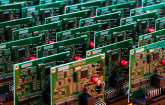NEW YORK, Sept. 14, 2023 /PRNewswire/ -- The water quality sensor market size is expected to grow by USD 1.58 billion from 2022 to 2027. However, the growth momentum of the market will progress at a CAGR of 6.72% during the forecast period. The market is segmented by application (groundwater, drinking water, wastewater, aquaculture, and others), type (residual chlorine, total organic carbon (TOC) sensor, ph sensor, oxidation-reduction potential (ORP) sensor, and others), and geography (APAC, North America, Europe, South America, and Middle East and Africa). Increasing focus on monitoring the water quality in the industrial sector is a key factor driving market growth. The high demand for water resources is driven by factors such as population growth and urbanization. In addition, utilities are finding it difficult to manage water distribution due to increasing water scarcity and rising energy costs. Water reuse and recycling are increasingly popular to address the water crisis. In addition, water is widely used in many industries such as food and beverage, pharmaceutical, petroleum, chemical, and petrochemical. These industries are increasingly adopting techniques to reuse and recycle the wastewater they generate due to a number of factors such as increasing water pollution and limited access to safe drinking water. Hence, these factors are expected to drive market growth during the forecast period. The report analyses the market size and growth and provides accurate predictions on the growth of the market. View FREE PDF Sample
Key Highlights:
- The report recognizes the following as some of the key players in the water quality sensor market: ABB Ltd., Campbell Scientific Inc., Cole Parmer, Danaher Corp., Dwyer Instruments Inc., Emerson Electric Co., HORIBA Ltd., ifm electronic gmbh, KROHNE Messtechnik GmbH, Libelium Comunicaciones Distribuidas SL, PASCO, Reynolds Culligan, scan GmbH, Sensorex USA, Siemens AG, SWAN Analytical USA INC., Thermo Fisher Scientific Inc., Tianjin Sure Instrument Co. Ltd., Zhengzhou Winsen Electronics Technology Co. Ltd., and Endress Hauser Group Services AG
- Water Quality Sensor Market is fragmented in nature.
- Market to observe 5.2% YOY growth in 2023.
Major Trends
- Increasing public-private partnerships (PPP) investments in water and wastewater treatment plants is a major trend in the market.
Significant Challenge
- Threat to cybersecurity is a significant challenge restricting market growth.
The report also covers information on upcoming trends and challenges. Explore detailed information by purchasing a report
Key Segments:
- The groundwater segment is estimated to witness significant growth during the forecast period. Monitoring of groundwater as well as surface waters is the key purpose of water quality sensors. Lakes, rivers, wetlands, and estuaries are among the most important sources of surface water. In terms of human drinking water, the groundwater segment is regarded as a major source. Furthermore, the level of groundwater and surface water has been adversely influenced by the increasing use of chemical fertilizers on agricultural lands and land pollution through municipal drainage systems. In addition, these sensors detect phenomena such as algal blooms, sediment flows, and floods, whether for groundwater protection, management research, or ongoing monitoring. Hence, these factors are expected to drive segment growth during the forecast period.
Get a glance at the market contribution of the segments, Request a FREE Sample
Related Reports:
The temperature sensor market size is estimated to grow at a CAGR of 5.41% between 2022 and 2027. The market size is forecast to increase by USD 1,963.5 million. This report extensively covers market segmentation by type (wired and wireless), end-user (oil and gas, chemical and petrochemical, automotive, manufacturing, and others), and geography (North America, APAC, Europe, Middle East and Africa, and South America). Increasing demand for temperature sensors in medical applications is the key factor driving the growth of the market.
The ultraviolet (UV) disinfection equipment market size is estimated to grow at a CAGR of 4.83% between 2022 and 2027. The market size is forecast to increase by USD 788.3 million. This report extensively covers market segmentation by end-user (residential, commercial, and municipal), application (drinking, waste, industrial, and others), and geography (North America, Europe, APAC, Middle East and Africa, and South America). The emergence of customized UV disinfection equipment is the key factor driving the growth of the market.
ToC:
Executive Summary
Market Landscape
Market Sizing
Historic Market Sizes
Five Forces Analysis
Market Segmentation by Application
Market Segmentation by Type
Market Segmentation by Geography
Customer Landscape
Geographic Landscape
Drivers, Challenges, & Trends
Company Landscape
Company Analysis
Appendix
Technavio is a leading global technology research and advisory company. Their research and analysis focus on emerging market trends and provide actionable insights to help businesses identify market opportunities and develop effective strategies to optimize their market positions. With over 500 specialized analysts, Technavio's report library consists of more than 17,000 reports and counting, covering 800 technologies, spanning across 50 countries. Their client base consists of enterprises of all sizes, including more than 100 Fortune 500 companies. This growing client base relies on Technavio's comprehensive coverage, extensive research, and actionable market insights to identify opportunities in existing and potential markets and assess their competitive positions within changing market scenarios.
Contacts
Technavio Research
Jesse Maida
Media & Marketing Executive
US: +1 844 364 1100
UK: +44 203 893 3200
Email: [email protected]
Website: www.technavio.com
SOURCE Technavio

WANT YOUR COMPANY'S NEWS FEATURED ON PRNEWSWIRE.COM?
Newsrooms &
Influencers
Digital Media
Outlets
Journalists
Opted In




Share this article